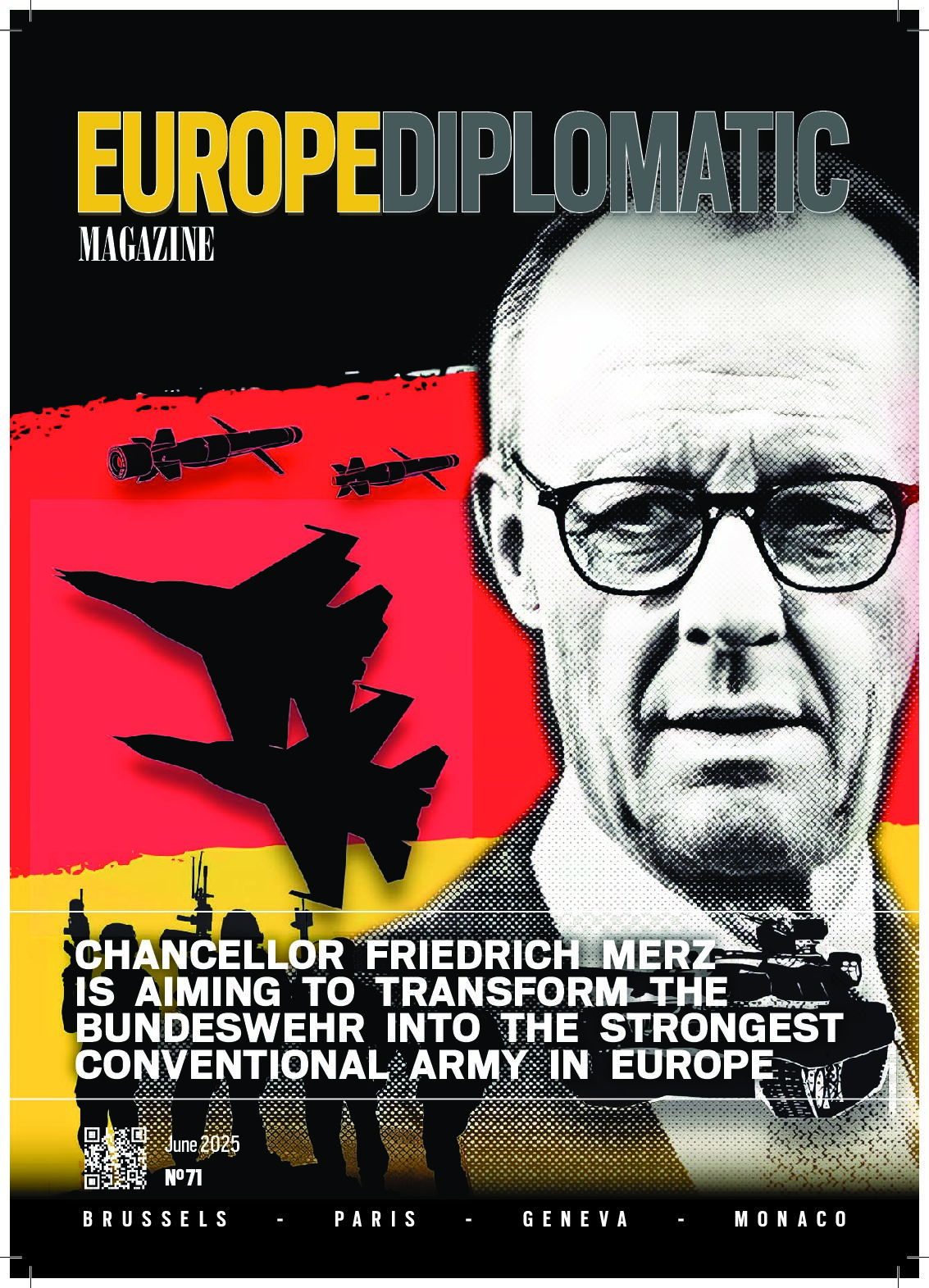A painting of the conquest of Constantinople by The Crusaders In 1204 by David Aubert (1449-79) © Nrf
Istanbul is, by any calculation, a unique and fascinating city. It used to be Byzantium, then became Christianised as Constantinople, named after the Emperor Constantine the Great. He is credited with being a foundation stone of both Western (Catholic) and Eastern (Orthodox) forms of Christianity (mainly viewed as an offshoot of Judaism at the time), as well as a number of other derivatives that were either absorbed, suppressed or in which their followers lost interest. As the inheritor of Rome’s empire (which was waning at the time), it was one of the most influential places in the ancient world. “Aucun nom n’est plus prestigieux que celui de Byzance; il n’en est pas qui suscite dans les imaginations un plus éclatant cortège de tragedies sompteuse et confuses.” (“No name is more prestigious than that of Byzantium; there is none that arouses in the imaginations a more dazzling procession of sumptuous and confused tragedies,” wrote Auguste Bailly, the great French novelist and historian in his informative 1939 book, simply entitled ‘Byzance’. I picked up a tattered copy at Brussels’ Place de Jeu de Bal flea market several years ago; having had its illustrations cut out, it was being thrown away, and very interesting it has proved to be for a book that cost me nothing. Bailly had a gift for telling a complicated story simply; his 1924 book about Naples and Vesuvius, “Naples au baisser de feu” (Naples: the kiss of fire), has been made into a movie four times, including by Hollywood (under the title ‘Flame and Flesh’).
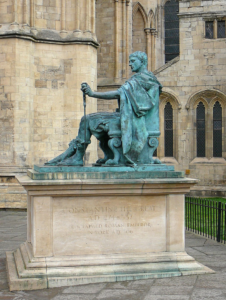
But getting back to the Emperor Constantine, he is an important historical figure for Christians, even though he only converted from Roman pagan beliefs fairly late in life, and was baptized just before his death in A.D. 337. Never-the-less, he had passed laws that made the practice of Christianity legal and also helped convoke the Council of Nicea in 325, from which Christians today still draw clearer definitions of what they’re supposed to believe: the Nicene Creed. Historians wonder just how devout he really was, something we’ll never know for sure. In his case, it could all have been political. It was a later successor, Theodosius, who really made Christianity the state religion. In any case, Constantine ruled what was the descendent empire of Rome from 306 to 337, and seems to have made quite a good job of it. Constantinople, however, remained a controversial place for Christian leaders, who seemed to have widely divergent views on it, so it came as little surprise when the 4th Crusade, launched by Pope Innocent III, turned aside from trying to recapture Jerusalem from Muslim forces and instead turned its violent attentions towards Constantinople in 1204. Crusaders seldom kept their word, nor were their actions very ‘Christian’: they set a prostitute on the emperor’s throne, and she sang filthy songs while swigging wine from the church’s holy vessels. The Venetians in the army refused to take part, but French soldiers destroyed silver icons and many beautifully produced books and also raped several Orthodox nuns. All-in-all, it was not Christianity’s finest hour, and it caused a rift between Western and Eastern Christianity that survives to this day.
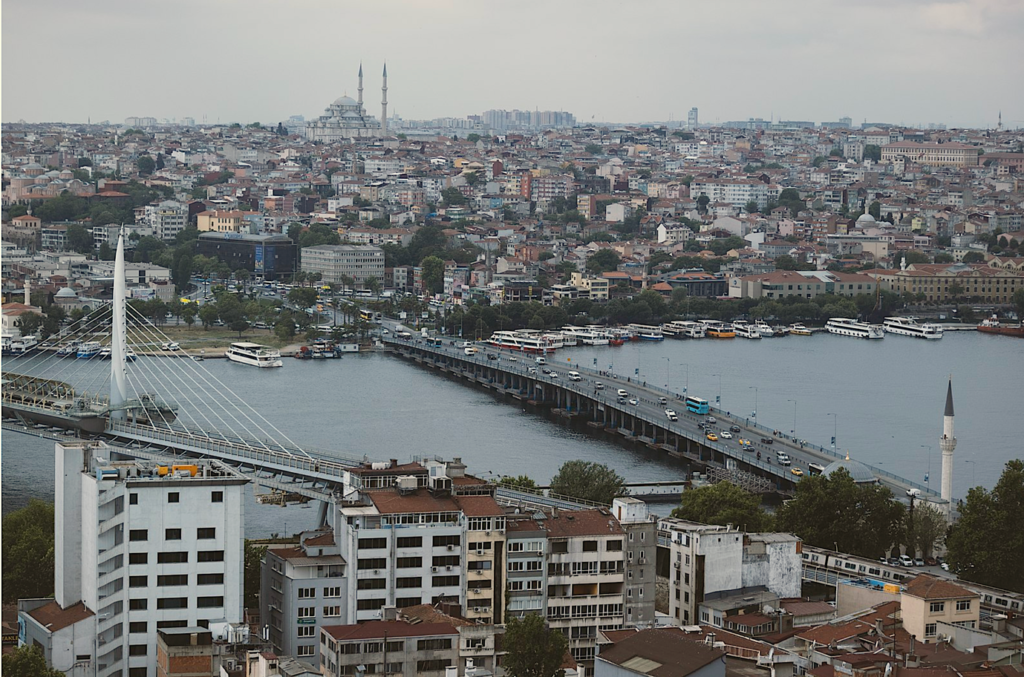
Istanbul, as it’s now known, of course, straddles two continents, standing at the geographical point at which Europe and Asia are joined. It is a fascinating and wonderful city that I don’t think one could ever tire of exploring. It also has excellent and inexpensive restaurants and it has the fabulous Spice Market, a feast for the eyes, the nose and (with a skilful cook) taste buds. I was taken there by a friend who acted as a guide and we ate our lunch in a restaurant above the spice market that is quite hard to spot unless you know it’s there. There was, of course, a framed photograph of Mustafa Kemal Atatürk gazing down at us as we ate the excellent food and sipped our raki. Raki is Turkey’s national drink, made from twice-distilled grapes and anise, I was told. It probably didn’t help the steadiness of my hand as I filmed that afternoon. I have tasted it since but I have never enjoyed it as much as I did there.

Like many a tourist, I have stood at the point on the Bosphorus Bridge where one continent ends and another begins (in theory). I also travelled over the same supposed spot in a water taxi, apparently controlled by a kind of latter-day Captain Ahab chasing Moby Dick. It was a very bouncy ride, with him aiming his fairly small boat at every wave he could see as well as diametrically across the wake of the largest ships. The Bosphorus is a natural strait, linking the Sea of Marmara to the south with the Black Sea to the north, and it is a very busy waterway, ploughed by vessels of every size imaginable, from tiny rowing boats to huge supertankers and even, in 2018, the ‘Pioneering Spirit’, a dual-purpose pipe-laying and heavy lifting vessel, described on the website of The Maritime Executive as ‘the world’s largest vessel’ in gross tonnage terms at 400,000 gigatons (441 million metric tonnes) and nearly 124 metres in the beam. It has a displacement of 900,000 tons (992 million metric tonnes). She is the world’s largest-capacity pipelaying vessel. The Strait itself, which is 31 kilometres long and up to 3,300 metres wide, although in some places much narrower, had to be closed to let the vessel through.
BIGGER, WETTER, LESS SALTY
It looks like soon being joined by another waterway, a man-made canal this time, also joining the Black Sea with the Sea of Marmara, thus providing a maritime link to the Aegean and the Mediterranean. It will cut right across the European side of Turkey, effectively turning Istanbul into an island, with the new Canal to Istanbul’s West and the Bosphorus to its East. The canal would give Istanbul shorelines on the new canal, the Bosphorus and the Black Sea. In fact, of course, Istanbul isn’t “on one side” of the Bospherous: it sits astride it. You can cross from Europe into Asia without ever leaving the city. The idea is to provide relief for the over-burdened Bosphorus, where ships can find themselves queuing to get through. Some have speculated that Turkey may also have an ulterior motive. The Montreux Convention, signed in 1936, gives Turkey control over the Bosphorus and the Dardanelle Straits, regulating the flow of naval warships, while guaranteeing free passage to civilian vessels, except in times of war. Even in peacetime, though, it restricts the passage of naval vessels that don’t belong to Black Sea states (which is why Russia is a fan). In addition to the new canal itself, the development will mean the construction of new ports, including a large container terminal near to Atatürk Airport, Istanbul’s principal airport for cargo, maintenance and business flights. Ordinary passenger transport switched to a huge new commercial airport in the European part of the city in April 2019. When it’s completed, it will be able to handle some 200-million passengers a year.
The soil extracted in the digging of the huge canal will be used in the construction of artificial islands, which will be integrated into the canal plans, as well as supposedly “earthquake-proof” residential areas.
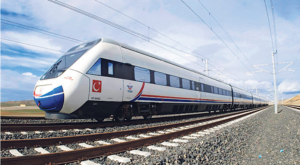
There are transport projects under way, connected to the canal, including the Halkali-Kapikule high-speed train, the Yenikapi-Sefakoy-Beylikduzu and Mahmutbey-Esenyurt metro lines in Istanbul, as well as the D-100 highway crossing. It all sounds very exciting (especially for residents of Turkey or those whose business interests make them regular visitors) but the idea isn’t exactly new. It was first put forward in the 16th century by the Ottoman Sultan, Suleiman the Magnificent (محتشم سليمان) as the West called him, or as Suleiman the Lawgiver (قانونی سلطان سليمان) as he’s known in Islamic lands. Work began but was suspended for unknown reasons. There have been further proposals since then, which similarly came to nothing. In the first half of the 20th century an alternative (and somewhat ambitious ) idea was put forward: a hydroelectric dam across the Straits of Gibraltar to lower the Mediterranean by 200 metres. There would have had to be another dam across the Dardenelles, too. With some 41,000 vessels of varying types and sizes passing through the Bosphorus Strait every year – that’s almost three times the tonnage passing through the Suez Canal – there is always a risk of damage, especially with roughly 8,000 of those vessels being tankers, carrying some 145-million tons (131.542 metric tonnes) of crude oil. In fact some 3% of the world’s total volume of oil passes through the Bosphorus. Furthermore, there has been some international pressure on Turkey to increase the possible throughput of marine traffic. What’s more, the volume of traffic is increasing. Among vessels greater than 200 metres in length, there were 3,653 in 2006, with a gross tonnage of 475,796,880 tons (431,635,669 metric tonnes).
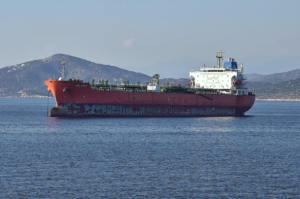
By 2018, it had risen to 4,106 vessels with a gross tonnage of 613,088,166 tons (556,184,228.5 metric tonnes). There is an apparent security risk here. It’s hoped that the canal will also reduce the pollution that is currently being caused by having cargo vessels passing through or mooring in the Sea of Marmara.
It is, of course, an enormous project and one that will take a long time to complete. It also has a lot of opponents, as large-scale projects are always likely to have. Turkey’s controversial president, Recep Tayyip Erdoğan, claims the canal will cost some €8.5-billion to complete, with the project needing up to 10,000 people in the construction phase, and then up to 800 people to operate it. It will, inevitably, have environmental consequences, too, with north-south flow of water through it leading to the effective desalination of the top 25 metres of the Marmara Sea, although the ecosystems at both ends would be affected. At what might be regarded, perhaps, as a more prosaic level, many locals are complaining that the canal will destroy agricultural land and forest, along with a popular walking trail, as well as possibly contaminating groundwater with salt. It’s also been suggested that changes to the salinity of the Sea of Marmara could lead to Istanbul smelling of hydrogen sulfide (H2S). Or to put it another way, rotten eggs. And, as I mentioned before, some are accusing Erdoğan of seeking to get around the Montreux Convention so as to gain greater autonomy over the passage of military vessels from the Black Sea to the Sea of Marmara and in the other direction. Many critics think the stated timetable for opening the canal in 2023 is simply not workable; the project is just too big.
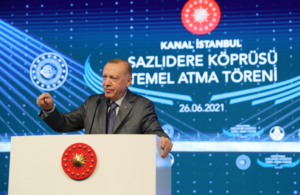
Erdoğan also faces opposition from Istanbul’s city authorities and from local groups because it would, apparently, eliminate Lake Durusu, from where comes 20% of the city’s drinking water. There are fears, too, that it could cause overcrowding because more people will move in for the work and the housing. Lake Durusu was originally a lagoon that became separated from the Black Sea coast, leaving it with no direct connection to the sea. Instead, it is fed with fresh water from a number of creeks, its current area extending to 392 kilometres with a depth of 11 metres. Its surface is 4.5 metres above sea level.
Erdoğan has spoken of charging transit fees to oil and gas tankers using the new canal, but critics say that’s unrealistic since free passage through the Bosphorous is guaranteed under the Montreux Convention. It does, however, allow for sanitary inspections before vessels enter the Bosphorous, which some think Turkey might use as a way to ‘persuade’ ships’ masters to use the canal instead. Members of the Qatari royal family have bought property along the route, as has Turkey’s Minister of Finance and son-in-law of Erdoğan, Beret Albayrak, allowing both to benefit financially from the anticipated real estate boom. Meanwhile, Turkey’s propensity to suffer earthquakes may prove to be a factor: a magnitude 5.3 earthquake shook both Turkey and Greece on 3 August, just 51 kilometres off the Greek coast.
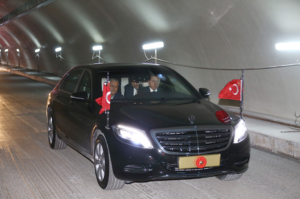
It was followed by another 5.1 magnitude quake four days later, 54 kilometres from Greece, and then by three more slightly smaller ones on the 6th. On 30th October 2020, a 6.6 (some have put it as high as 7.0) magnitude earthquake in the Aegean Sea hit the area around Izmir, killing 114 people and injuring more than a thousand. The quake even caused a tsunami in the ancient town of Sigacik. So earthquake-resistant housing is important and Istanbul’s mayor, Ekrem Imamoglu, said that limited financial resources should be used in preparing Istanbul itself for something worse. Perhaps that’s why some 80.4% of Istanbul’s residents are said to be opposed to the canal project. In April this year, ten retired Turkish admirals were arrested for criticising the canal project. Erdoğan does not like to hear anyone criticise what he does (or says).
POPULISM IN THE PAST
Erdoğan’s predecessors had less of a problem with public opinion; they ignored it. This also applied when a later successor of Constantine the Great, Theodosius, applied the Nicene Creed more vigorously, and who strengthened the walls most firmly against invaders and who defeated Magnus Maximus and Eugenius in civil wars over the crown. His strengthening of Constantinople was impressive, if not universally popular (Emperors of the Roman Empire, even the Eastern one, still had plenty of enemies), coming as it did after further beautification of the mighty city, thus making it mightier still. “Centre commercial et centre intellectuel,” wrote Bailly, “aussi passionnément éprise d’esthétique que de métaphysique, infiniment humaine et n’attachant pas de prix à la vie, offrant aux regards le spectacle simultané de ses foules grouillantes, installé dans ses quartiers immonde, et de ses élites fastueuses pour qui s’élevaient des palais de marbre et d’or, poussant au dernier raffinement toute les subtilités de la pensée, mais conservant l’irrésistible élan de toutes les passions primitives, Constantinople était bien la capitale d’un monde nouveau, point de rencontre et de fusion de trois civilisations – celle de Rome, d’Athène, et d’Orient – qui, s’interpénétrant et se fondant, allaient donner naissance à la civilisation byzantine.” (Centre of commerce and centre of intellectual thought, as passionately in love with aesthetics as with metaphysics, infinitely human and not putting a price on life, offering to the gaze the simultaneous spectacle of its swarming crowds, installed in its filthy neighborhoods, and of its ostentatious elites for whom arose palaces of marble and gold, pushing to the last refinement all the subtleties of thought, but retaining the irresistible impetus of all primitive passions, Constantinople was indeed the capital of a new world, a meeting point and fusion of three civilizations – that of Rome, Athens, and the East – which, interpenetrating and merging, were to give birth to Byzantine civilization.) It seems Theodosius got quite a lot of things right; is Erdoğan doing as well? According to media reports, the Turkish people don’t altogether share his enthusiasm for the canal project.
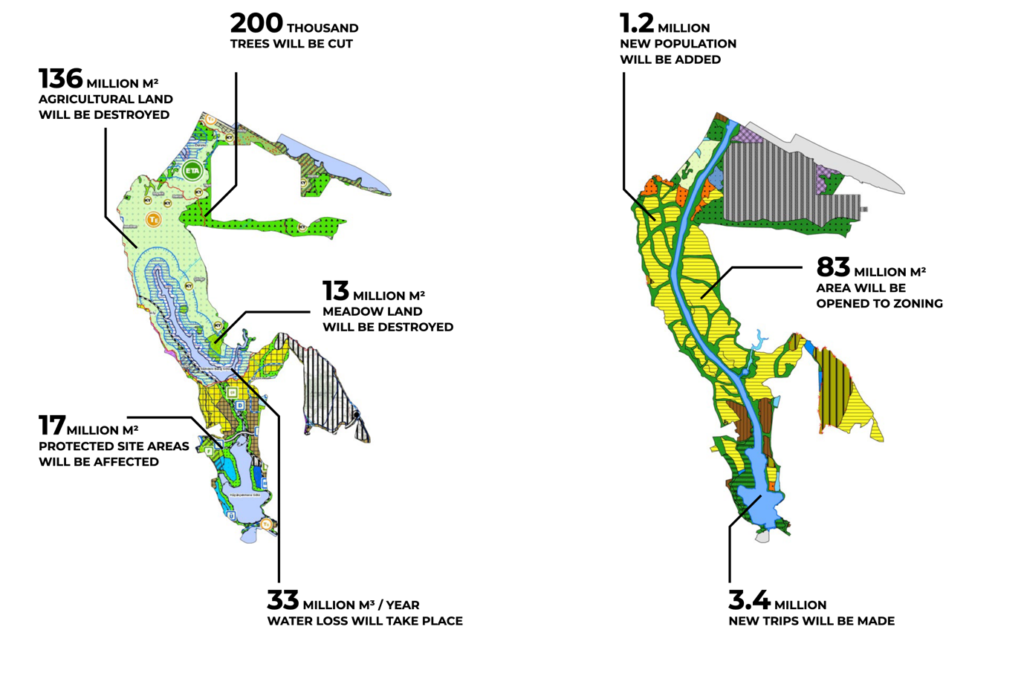
The canal will have six crossing places and in June this year Erdoğan laid the first stones of one of them, the Sazlidere bridge. In his speech at the ceremony, Erdoğan strongly defended what he has himself called his “crazy project”. He said the canal is vital to defend the citizens of Istanbul and to allow Turkey to take “a more important place” in international trade. He dismissed criticism about the massive costs, arguing that “All stages of the project have been designed in accordance with science.” The plan has not pleased Vladimir Putin, who can foresee NATO warships getting easier access to the Black Sea, which Putin views as his back yard. “We view Kanal Istanbul as a project to save Istanbul’s future,” said Erdoğan at the ceremony. “We are opening a new page in the history of Turkey’s development.” Apart from the massive construction costs, which Turkey will not find it easy to meet, the opportunities to profit from the work are potentially enormous.
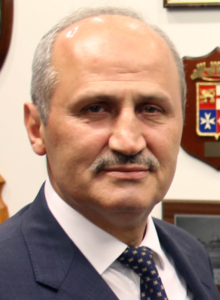
This massive project should provide safe passage for up to 185 ships every day, a big step up from the 118 to 125 currently passing through the Bosphorous Strait, according to Cahit Turhan, Turkey’s transport minister, speaking in January. He told the media that the throughflow of vessels could bring in as much as $1-billion (€0.85-billion) a year. In an interview for Turkey’s Anadolu news agency, Turhan predicted that some 50,000 ships would pass through the canal in 2035, rising to 70,000 in 2050 and 80,000 in 2070, with Turkey earning $5-billion (€4.25-billion) for every 50,000 ships passing through, not to mention an additional $250-million (€213-million) from ports and logistics centres. There is no doubt that the new canal could be a money-spinner for Turkey, as well as having the added benefits for Erdoğan of making NATO happy and annoying the Russians. However, Turkey has a record for under-estimating costs and over-estimating revenues resulting from proposed new schemes. Six of the country’s largest banks have signed a sustainability pact that would make it difficult, if not impossible, for them to lend the money to fund construction. Furthermore, the public-private partnerships (PPP) the government has used to fund other infrastructure projects have proved more costly than was forecast and as a result, Turkey has been obliged to use billions of dollars (Turkey always estimates in US dollars) from public funds on covering shortfalls, while the value of the Turkish lira has continued to fall.

STAYING ALIVE AND AFLOAT
Istanbul is a fascinating place to visit, full of wide parks and boulevards, quaint streets with interesting shops and lined with magnificent buildings, many of them extremely old, while the air is rich with the muezzin calls from the minarets of many mosques.
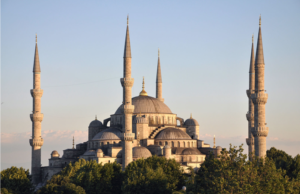
They’re supposed to sing well, too: from time to time, the city mayors had their voices tested for sweetness. The tone-deaf and ungifted were told to leave the call to prayer to more musical singers but were also instructed to take singing lessons. With five calls to prayer every day, it’s important. Those I heard in Istanbul whenever I was there had remarkably good voices. It pays to take care there, of course, as it does in most large, bustling cities. Driving is extremely hazardous: Turkey has the world’s second highest death rate: 77 deaths for every 100,000 vehicles on the road. The European average is 18.2, in France it’s just 8.4, in Germany 6.4, in the UK 5.7. People are sometimes ripped off by taxi drivers, but that’s a worldwide problem: I was similarly ripped off once in New York. However, cases of muggings and assaults are relatively rare, if simple pickpocketing is not. Having seen the place, I can only say that in my opinion, it is well worth the risk. The existence or otherwise of a canal running parallel to the Bosphorus doesn’t affect Istanbul’s appeal, at least not as yet.
Demand for a new way to cross from the Sea of Marmara to the Black Sea, however, has not come from the shipping companies, despite the long waits to get through the Strait, according to the website MEI@75 (Middle East Institute). Despite an increase in the tonnage passing through, there has actually been a slight decline in the actual number of vessels. The queuing doesn’t seem to bother the maritime transportation business too much. Over the last 13 years, the average wait time to enter the Bosphorus has been 13.7 hours. This is partially due to weather conditions, such as high winds and fog, but also due to the lack of coastal safety equipment like tugs and firefighting boats that accompany tankers. In any case, navigating narrow, shallow canals had always posed problems for ships’ captains, as the blocking of the Suez Canal by the vessel Ever Given proved. “Strong wind, current, any mechanical or engine failure, or human error could cause ships to veer off course and block the entire canal,” warned MEI@75, while most of the ships’ captains who spoke to the Turkish service of German broadcaster DW said they’d prefer to stick with the Bosphorus.
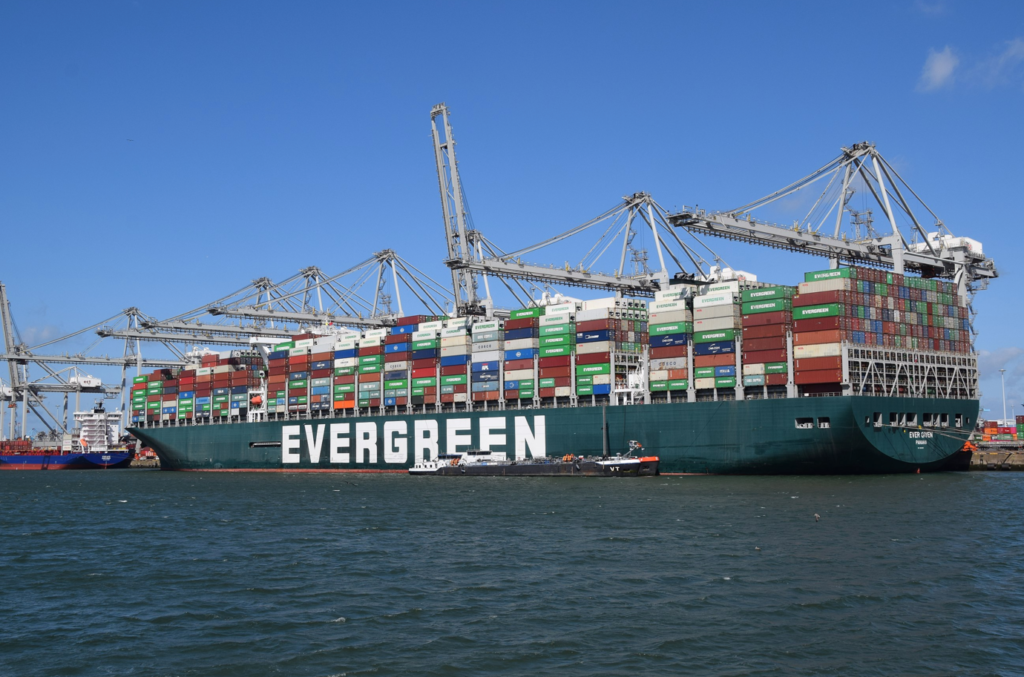
Furthermore, the construction cost estimates made public don’t factor in the value of new and displaced infrastructure – things like roads, pipes, power lines, railway lines and housing neighbourhoods and which could mean that the cost may reach $250-billion (€213-billion) by 2030. In addition, not only would the canal destroy two of Istanbul’s water reservoirs, it would also risk irreversibly contaminating the groundwater reserves of Istanbul and the entire Thrace region. MEI@75 doesn’t agree with some pundits that this is all about sidestepping the Montreux Convention. “The relevant questions are how to provide maritime security in the Black Sea, limit Russia’s territorial incursions toward NATO partner countries like Ukraine and Georgia, and perhaps how to counter Russian meddling in Turkey’s new energy projects in the Black Sea,” argues the website. “What’s needed is a permanent NATO group, consisting of rotating ships in line with the Montreux treaty’s time limitations.” I suspect that such an option would annoy the Kremlin even more than the proposed canal. Under the Montreux Convention, the Bosphorus is an international waterway; Turkey only has the right to manage it.
The Irish poet W.B. Yeats clearly imagined Byzantium as a place for pleasure, but only for the young. “That is no country for old men,” is the opening line of his 1928 poem, ‘Sailing to Byzantium’. “The young / In one another’s arms, birds in the trees – / Those dying generations – at their song, / The salmon-falls, the mackerel-crowded seas, / Fish flesh or fowl, combined all summer long / Whatever is begotten born and dies. / Caught in that sensual music all neglect / Monuments of unageing intellect.” He was right about the abundance of fish; Istanbul is famous for it. It is celebrated in a 12th century codex, the Codex Matritensis of Skylitzes, showing men hauling in their full nets. The matter is referred to by the Roman historian Tacitus in his 1st century AD ‘Annals’: “For Byzantium has a fruitful soil and productive seas, as immense shoals of fish pour out of the Pontus and are driven by the sloping surface of the rocks under water to quit the windings of the Asiatic shore and take refuge in these harbours.” Will they take refuge as happily in the new harbours that will be created in Erdoğan’s “crazy scheme”? Given the region’s historic, even classical, connections, opposition to the canal is inevitable.
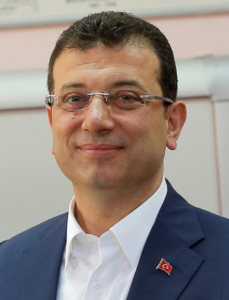
As reported on The Maritime Executive’s website, “The project’s detractors say that it would harm the marine environment in the Sea of Marmara, destroy some of the area’s last forest reserves, threaten Istanbul’s fresh water supply and heighten the risk of damage in the event of a major earthquake.” One of the most prominent of the canal’s opponents is the Mayor of Istanbul, Ekrem Imamoglu, who dismissed the high-profile laying of foundations for a new bridge, pointing out that plans for the bridge came before any plans for a canal, having been in the planning since 2006. “The construction of a bridge here has nothing to do with the canal project. It’s something to do with the road hub,” Imamoglu said. In all societies, in every period of history, it seems, there is factual reporting and there is propaganda, and they are not at all the same thing.
The project is expected to be built under public-private cooperation, despite occasional problems with previous PPPs. At the meeting at which Erdoğan announced the project, he said it would be financed entirely through what he called ‘national resources’. If his predictions come true (and it’s quite a big ‘if’, according to some experts), once the tender process has been dealt with, the project is expected to be completed in six years, with around one-and-half-years of preparatory work followed by five-and-half years of construction. Six bridges will be built over the canal, “transforming Istanbul into a city with two seas”, according to the TRT World website. ‘Cities’ containing some 250,000 residences are planned to be built on either sides of the canal, so it should help answer some of the city’s housing problems.

“The mega-project, meant to prevent risks posed by vessels carrying dangerous shipments through the Bosphorus Strait” says TRT World, “was approved by the country’s Environment and Urbanization Ministry.” The controversy is unlikely to go away, but there is a discernible determination to see it through, regardless of comments from its many detractors and the doubts over how it can be financed. “This is going to be a brand-new page in Turkey’s development,” said Erdoğan. “On the path to this development, we will leap forward. This will save Istanbul’s Bosphorus waterway.” But the Mayor of Istanbul is not the only voice to be raised in opposition, according to Voice of America. In an interview, marine biologist Cemal Saydam, claimed that the government was ignoring scientists, whose concerns are well-founded. “If you are connecting two marine bodies, you have to ask the opinion of marine scientists, which they have not done,” Saydam said. “Scientifically, it’s going to devastate the Sea of Marmara for sure, and it’s going to devastate the Black Sea for sure, and it’s going to change the whole water budget of the Mediterranean Sea, as well, because there are interconnected seas.”
It seems most unlikely that Erdoğan will take any notice or change his mind. This is a prestige project and its successful conclusion can only boost Erdoğan’s personal prestige. It cannot be allowed to fade away. Given the sort of things that have happened in the region for more than two millenia, it is also quite likely that even “irreversible harm” can probably be reversed, given time. Anyone remember ‘Greek fire’, the superweapon Constantinople used against the ships of Arab invaders? Also known as Sea Fire, Sticking Fire or Roman Fire, it generated screaming noises, said to be ‘terrifying’ and gave observers the impression that the surface of the sea was on fire. Today, we don’t even know what it was, nor how the Greeks made it. But the Sea of Marmara and the Black Sea are still there, and likely to remain so. As for the possible environmental damage, it’s hard to believe that such concerns rate highly on Erdoğan’s list of worries. When all the arguments die down, whether or not Turkey has its canal (it probably will, unless Erdoğan negotiates it away in talks with Russia), Istanbul will return to its normal way of life, where the reportedly beautiful Theodora did very naughty exotic dances (think Leda and the Swan) and slept around among all the visiting officials in order to uncover their military plans and secrets. It was tough on Constantinople’s enemies: defeated by Greek Fire and Theodora’s bed.
